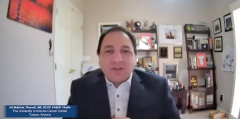
What to Know When Treating ITP With a SYK Inhibitor
Episodes in this series

Recommendations for dosing fostamatinib, a SYK inhibitor, and managing adverse events and drug interactions when utilizing the drug to treat relapsed immune thrombocytopenia.
Bhavesh Shah, RPh, BCOP: Interestingly, talking about the mechanism, this might be a silly question, but does fostamatinib work whether you have a spleen or don't have a spleen?
Ali McBride, PharmD, MS, BCOP, FASHP, FAzPA: It's almost a trick question and great for the discussion. It still works, actually. Even though it's called spleen tyrosine kinase, or SYK, it has intracellular tannin repeat. SYK was identified molecularly and identified based on the name of the location it was discovered from. In terms of molecular-based sequencing and characterization, SYK is a common protein. It's seen intracellularly, binds into intracellular domains, and it has regulations for many different pathways, through PI3 kinase, ITAM [immunoreceptor tyrosine-based activation motif] signaling, Akt signaling, and mTOR signaling. We have a multitude of cascades associated with this. But also, to note, it's associated with the actual Fc binding domain, adding to David's discussion about the Fc receptor and some new trials coming out. We’re seeing SYK regulation across the board in the area where you have the binding between the actual molecule, the antibody, and ITAM, or intracellular tannin repeats, where it has that efficacy for signaling. Even though we've denoted this name based on the actual site for characterization and discovery, it has a large and abundant role in other areas of the body, regardless of the spleen itself. Hopefully that clarifies any doubt.
Bhavesh Shah, RPh, BCOP: Thank you, and I always like to throw that question out there. Also, if you look at the results from the FIT-1 and FIT-2 trials, there was no difference in response rates for patients who had a spleen versus patients who didn't have a spleen.
You both have a lot of experience with this drug. Are there any drug interactions you need to worry about or any food, things like that? Some drugs are very sensitive to specific types of food. Can you provide some insight on that?
David Hughes, PharmD, BCOP: Fostamatinib is available as a single tablet. It's a 100-mg tablet at the initial starting dose. It's taken 2 times daily with or without food. When the FIT-1 and FIT-2 trials were done, there was a 150-mg dose that could be given to patients who did not respond by week 4. It is available as a 150-mg tablet. That's, again, another twice-daily tablet that you would take in addition.
When you think about the adverse effect profile of fostamatinib, there are really 2 key adverse effects to think about with this drug: hypertension and diarrhea. The most important thing is recognizing these in the up-front setting and warning patients of these adverse effects at home.
For instance, have Imodium [loperamide hydrochloride] or something with loperamide at home to manage these symptoms, because over time, it usually becomes self-limiting after the first few weeks of therapy. We haven’t seen these adverse effects hang around, at least in my practice. For blood pressure, these aren't emergency cases of hypertension being reported in the FIT trials. These are just small increases by about 5 mm of mercury. A lot of times at baseline, if you have a patient with hypertension and they are already on antihypertensives, you may need to increase the dose slightly. If the patient is naïve, you may need to add a small dose of an antihypertensive. But I don't think these are things that are necessarily unmanageable compared to some of the other adverse effects we deal with in the ITP [immune thrombocytopenia] world.
Bhavesh Shah, RPh, BCOP: Thanks, David.
Ali McBride, PharmD, MS, BCOP, FASHP, FAzPA: That goes along with: What's your management? Are you doing telehealth? Are you doing home blood pressure counts twice a month? The other piece is drug interactions. One of the things that we always talk about is: do you have an oral chemotherapy program? Because we know that the actual metabolite can increase or have a regulation of exposure to the major metabolite with CYP3A4 inhibitors, which is R406, we always want to make sure we do some safety checks up front. We have to look at any drug therapies that can cause CYP3A4-based metabolism and activation or, in some cases now, the downstream effects with CYP3A4 substrates, not just with inhibitors, but also with BCRP, breast cancer-related protein. BCRP is another type of multidrug resistance protein, and we must look at how they may be regulated, as well as how P-gp [P-glycoprotein] substrates may be regulated. In addition to the monitoring, when patients come in on a monthly basis and change their therapy, we must check the medical recommendations. What do we need to do for that patient to make sure we're maximizing efficacy while minimizing adverse effect profiles, too?
Bhavesh Shah, RPh, BCOP: For those patients who are coming from 4 hours away, if you're starting them on this medication that may cause diarrhea, they need to know that as they're starting their therapy. It is important to have pharmacists involved, especially with some of these adverse effects, which can be managed pretty easily. Even the hypertension seems to be very manageable from what you said, David.
Newsletter
Stay informed on drug updates, treatment guidelines, and pharmacy practice trends—subscribe to Pharmacy Times for weekly clinical insights.
































































































































































































































